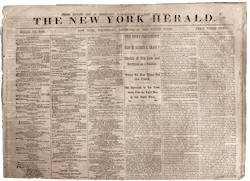April 16, 1863, The New York Herald
Our Suffolk Correspondence.
THE FIGHT.
ON THE SIGNAL TOWER (NINETY FEET HIGH),
April 14, 1863.
At eleven o’clock the enemy opened from the direction of the Sommerton road with heavy artillery. We replied with our batteries, when the enemy opened with some light field artillery against our left. To this latter fire we responded with our guns from Fort Dix. Another fort next, to the right, opened with its guns, and still another one, to the right of this again. The enemy replied with moderate rapidity, changing his position as fast as we obtained the range of his guns. Thus the cannonading continued for some little while.
The general scene at this time was one of peculiar interest. On General Terry’s front, a short distance forward, were two or three houses in full flames. Our infantry stood up to the breastworks, while our skirmishers were deployed for quite a distance forward all along in front. The enemy skirmishers stretched out about the same distance; but they had the advantage of rails and other things to protect them, while our men had to lay down and get up in a broad open space – one that we had cleared ourselves – on a smooth open plain. Our infantry reserves held their positions, with cavalry, to the right and left, the camps in the background forming an entire circle, the town in the midst of this; the tortuous, winding Nansemond behind this again, with its burthen of white and lead-colored gunboats, and etceteras always incident to scenes of this character. In less than an hour the enemy stopped firing, and fell back one mile. Our cavalry then went out to charge on a piece of artillery limbered up in the road, when a force of rebel sharpshooters rose up in the woods and delivered at them a whole volley.
We could now see that our shots had done some execution; for several of the enemy’s horses ran off riderless, while more lay dead in the road. Our cavalry retired, when the enemy advanced again with two sections and renewed the fight. So plain was the enemy to view that we could see their officers, or cavalry men, waving their swords and rushing to and fro in haste, and almost recklessness. The wind being strong, blowing towards the enemy, a detachment of the Eleventh Pennsylvania cavalry advanced again and set fire to several houses by the roadside. This they did in the coolest and quickest manner possible. Our shells also set fire to some woods near by. By this maneuver we caused a dense smoke to blow, so to speak, directly in the face of the enemy’s force working their guns. In order to get clear of the smoke the enemy would thus be compelled to move his artillery nearer, or to either side of the road, thereby giving us a better chance for sight and range. After this the firing became less lively, the enemy firing a few shots, then retiring, and then again advancing, and the like. Up to this period the engagement was confined to Acting Brigadier General Foster’s and Acting Brigadier General Murphy(Irish Legion) brigades.
By one o’clock the enemy had ceased firing, doing so only occasionally, and we were shelling them out of the woods.
A train is going to Portsmouth now, and I must close this despatch. My next one will contain the afternoon proceedings. We have no news yet of any one killed or seriously wounded.
